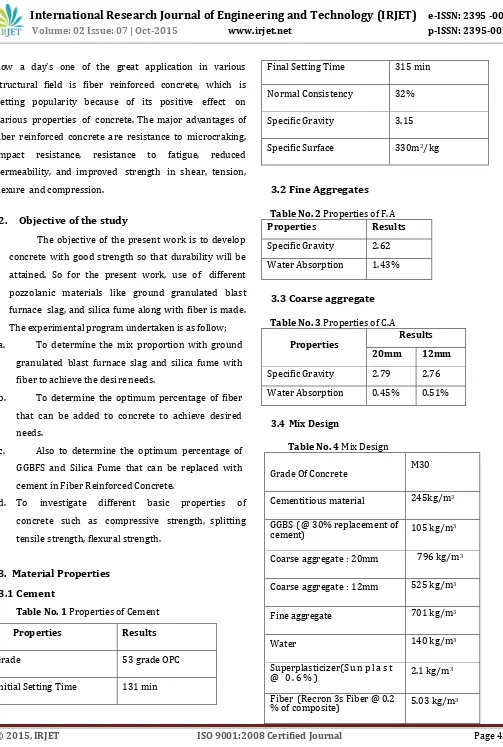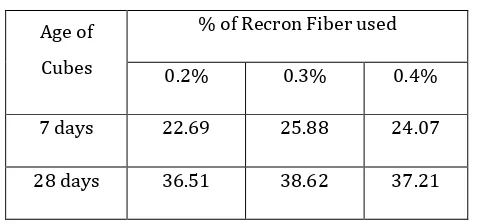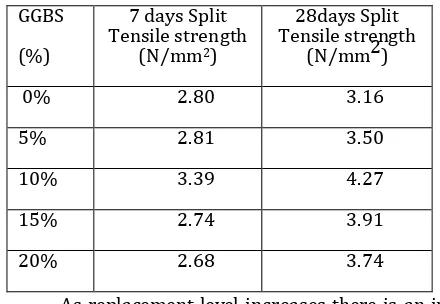© 2015, IRJET ISO 9001:2008 Certified Journal Page 438
Silica Fume & Ground Granulated Blast Furnace Slag as Cement
Replacement in Fiber Reinforced Concrete
Anusha Suvarna
[1], Prof .P.J. Salunke
[2],
Prof. N.G.Gore
[3]Prof. T.N.Narkehde
[4]1 PG Student, Department of civil engineering, MGM’s College of Engineering & Technology, Maharashtra, India
2 3 4Professor , Department of civil engineering, MGM’s College of Engineering & Technology, Maharashtra, India
---***---Abstract: A strength concrete is always a
high-performance concrete, but a high-high-performance concrete is not always a high-strength concrete. Durable concrete specifying a high-strength concrete does not ensure that a durable concrete will be achieved. It is very difficult to get a product which simultaneously fulfills all of the properties. So the
different pozzolanic materials like Ground
Granulated Blast furnace Slag (GGBS), Silica Fume, Rice Husk Ash, Fly Ash, High Reactive Metakaolin, are some of the pozzolanic materials which can be used in concrete as partial replacement of cement, which are very essential ingredients to produce high performance concrete. It is very important to maintain the water cement ratio within the minimal range, for that we have to use the water reducing admixture i.e. superplasticizer, which plays an important role for the production of high performance concrete. So I herein this project will test on different materials like Ground Granulated Blast Furnace Slag, and Silica Fume to obtain the desired needs. I will use synthetic fiber (i.e. Recron fiber) in percentage 0.2%, 0.3%, 0.4% to that of total weight of composite and casting will be done to find out the optimum percentage of fiber to be used. Finally I will use different percentage of Silica Fume & GGBS with the replacement of cement keeping constant the optimum fiber content and concrete will be casted. Compressive test, splitting test, flexural test will be conducted on the prepared mortar cubes, cylinders & prisms.
Keywords – Recron Fiber, Silica Fume, GGBFS, Strength Test.
1. Introduction
Concrete is the most widely used man-made construction material in the world. The utility and elegance as well as the durability of concrete structures, built during the first half of the last century with Ordinary Portland Cement (OPC) and plain round bars of mild steel, the easy availability of the constituent materials of concrete and the knowledge that virtually any combination of the constituents leads to a mass of
concrete have bred contempt. Strength was
© 2015, IRJET ISO 9001:2008 Certified Journal Page 439 now a day’s one of the great application in various
structural field is fiber reinforced concrete, which is getting popularity because of its positive effect on various properties of concrete. The major advantages of fiber reinforced concrete are resistance to microcraking, impact resistance, resistance to fatigue, reduced permeability, and improved strength in shear, tension, flexure and compression.
2. Objective of the study
The objective of the present work is to develop concrete with good strength so that durability will be attained. So for the present work, use of different pozzolanic materials like ground granulated blast furnace slag, and silica fume along with fiber is made. The experimental program undertaken is as follow; a. To determine the mix proportion with ground
granulated blast furnace slag and silica fume with fiber to achieve the desire needs.
b. To determine the optimum percentage of fiber that can be added to concrete to achieve desired needs.
c. Also to determine the optimum percentage of GGBFS and Silica Fume that can be replaced with cement in Fiber Reinforced Concrete.
d. To investigate different basic properties of concrete such as compressive strength, splitting tensile strength, flexural strength.
3. Material Properties
3.1Cement
Table No. 1 Properties of Cement
Properties Results
Grade 53 grade OPC
Initial Setting Time 131 min
Final Setting Time 315 min
Normal Consistency 32%
Specific Gravity 3.15
Specific Surface 330m2/kg
3.2Fine Aggregates
Table No. 2 Properties of F.A
Properties Results
Specific Gravity 2.62
Water Absorption 1.43%
3.3Coarse aggregate
Table No. 3 Properties of C.A
Properties Results
20mm 12mm
Specific Gravity 2.79 2.76
Water Absorption 0.45% 0.51%
3.4Mix Design
Table No. 4 Mix Design
Grade Of Concrete M30
Cementitious material 245kg/m3
GGBS ( @ 30% replacement of
cement) 105 kg/m3
Coarse aggregate : 20mm 796 kg/m3
Coarse aggregate : 12mm 525 kg/m3
Fine aggregate 701 kg/m3
Water 140 kg/m3
Superplasticizer(S u n p l a s t
@ 0 . 6 % ) 2.1 kg/m3
Fiber (Recron 3s Fiber @ 0.2
[image:2.595.41.544.40.787.2]© 2015, IRJET ISO 9001:2008 Certified Journal Page 440
4. Experimental Investigation
1.
Synthetic fiber i.e. Recron fiber is used in concrete for the production of fiber reinforced concrete. Recron fiber has been used in percentages i.e. 0.2%, 0.3%, and 0.4% to the weight of concrete and study the 7 days and 28 days compressive strength.2.
Out of 0.2%, 0.3%, and 0.4% addition of Recronfiber optimum percentage addition of Recron fiber is used for further study.
3.
Different percentages of silica fume i.e. 5%, 10%, 15%, 20% and fixing constant fiber percentage at optimum percentage i.e. at 0.3% cubes, cylinders and prisms were casted and tested to analyze the change in compressive, splitting tensile and flexural strength.4.
GGBS at different percentage i.e. 30%, 40%, 50%, 60% and fixing constant fiber percentage at optimum percentage i.e. at 0.3% cubes, cylinders and prisms were casted and tested to analyze the change in compressive, splitting tensile and flexural strength.5. Test Results
Table No. 5 Effect of Recron fibre on compressive strength
Age of Cubes
% of Recron Fiber used
0.2% 0.3% 0.4%
7 days 22.69 25.88 24.07
28 days 36.51 38.62 37.21
From the above result it was observed that using Recron fiber from 0.2% to 0.4% the compressive strength is maximum at 0.3%, i.e. from 0.2% to 0.3% compressive strength was increased and on further increment of fiber content the strength reduces. The 7 day and 28 days
compressive strength of concrete is higher at with 0.3% fiber compared to other fiber composition. So the optimum dosage of fiber for getting maximum strength for OPC is 0.3%.
Table no. 6 Effect of GGBS on compressive strength using 0.3% fiber
GGBS (%)
7 days Compressive
strength (N/mm2)
28days compressive strength (N/mm2)
0% 25.88 38.62
30% 26.02 38.81
40% 27.57 39.61
50% 30.46 41.49
60% 29.69 40.74
GGBS cement is added to concrete in the concrete manufacturer's batching plant, along with Portland cement, aggregates and water. GGBS is used as a direct replacement for Portland cement, on a one-to-one basis by weight. Replacement levels for GGBS vary from 30% to up to 85%. Typically 40 to 60% is used in most instances. In the study it was observed that cement when replaced with GGBS there is a considerable increase in compressive strength. Out of the four combinations considered cement replaced with 50% GGBFS shows higher strength and produced more workable concrete. In the 28 day strength there is an increase in strength for all the four combinations considered. Replacing cement with 50% G G B F S w a s c o n s i d e r e d a s t h e o p t i m u m cement replacement for M30 concrete.
Table no. 7 Effect of GGBS on Split Tensile strength using 0.3% fiber
GGBS (%)
7 days Split Tensile strength (N/mm2)
28days Split Tensile strength
(N/mm2)
0% 2.80 3.16
[image:3.595.43.283.558.670.2]© 2015, IRJET ISO 9001:2008 Certified Journal Page 441
40% 3.15 3.46
50% 3.60 3.78
60% 3.04 3.28
From the above result it is observed that as the replacement level increases there is an increase in split tensile strength for M30 grade of concrete up to 50% replacement level, and beyond that level there is a decrease in split tensile strength.
Table no. 8 Effect of GGBS on Flexural strength using 0.3% fiber
GGBS (%)
7 days Flexural strength (N/mm2)
28days Flexural strength (N/mm2)
0% 5.19 5.54
30% 5.23 5.88
40% 5.74 6.49
50% 6.40 6.94
60% 6.23 6.41
From the above observation it is clear that the flexural strength at the age of 28 days of GGBFS concrete continuously increased and reached a maximum value of 10%replacement level for M30 grade concrete respectively.
Table no. 9 Effect of Silica Fume on compressive strength using 0.3% fiber
GGBS (%)
7 days Compressive
strength (N/mm2)
28dayscompressive strength (N/mm2)
0% 25.88 38.62
5% 31.12 42.71
10% 33.53 44.59
15% 31.20 43.96
20% 29.85 43.27
There is a significant improvement in the strength of concrete because of the high pozzolanic nature of the
silica fume and its void filling ability. The compressive strength of the M30 mix at 7 and 28 days age, with replacement of cement by silica fume with 0.3% fiber content was increased gradually up to an optimum replacement level of 10% and then decreased. Cement replacement up to10% with silica fume with a constant fiber content leads to increase in compressive strength.
Table no. 10 Effect of Silica Fume on Split Tensile strength using 0.3% fiber
GGBS (%)
7 days Split Tensile strength
(N/mm2)
28days Split Tensile strength
(N/mm2)
0% 2.80 3.16
5% 2.81 3.50
10% 3.39 4.27
15% 2.74 3.91
20% 2.68 3.74
As replacement level increases there is an increase in split tensile strength for M30 grade of concrete up to 10% replacement level, and beyond that level there is a decrease in split tensile strength.
Table no. 11 Effect of Silica Fume on Flexural strength strength using 0.3% fiber
GGBS (%)
7 days Flexural strength (N/mm2)
28days Flexural strength (N/mm2)
0% 5.19 5.54
5% 5.25 5.70
10% 5.83 6.34
15% 5.44 6.10
20% 5.01 5.78
[image:4.595.42.283.96.169.2] [image:4.595.312.532.266.418.2] [image:4.595.46.281.293.441.2]© 2015, IRJET ISO 9001:2008 Certified Journal Page 442
6. Conclusion
1. Use of GGBS as cement replacement increases consistency.
2. Cement replaced with 50% GGBS with 0.3 % fiber shows higher compressive.
3. As the replacement level of cement by GGBS increases there is an increase in split tensile strength & flexural strength for M30 grade of conc+rete up to 50% replacement level, and beyond that level there is a decrease in split tensile and flexural strength. 4. Using 50% GGBS with 0.3% fiber percentage the 28
days compressive strength increases 7% more than concrete with 0.3% fiber only.
5. So it is inculcated that 0.3% Recron fibre and replacement of 50 % GGBS with cement is required to achieve desired needs.
6. As the replacement of cement with different percentages with Silica fume increases the consistency increases.
7. The compressive strength of the M30 mix at 7 and 28 days age, with replacement of cement by silica fume with 0.3% fiber content was increased gradually up to an optimum replacement level of 10% and then decreased.
8. As the replacement level of cement by silica fume increases there is an increase in split tensile strength & flexural strength for M30 grade of concrete up to 10% replacement level, and beyond that level there is a decrease in split tensile and flexural strength. 9. Using 10% silica fume with 0.3% fiber percentage
the 28 days compressive strength increases 13% more than concrete with 0.3% fiber only.
10. So it is inculcated that 0.3% Recron fibre and replacement of 10 % silica fume with cement is required to achieve desired needs.
References
[1] A Oner & S Akyuz, “An experimental study on optimum usage of GGBS for the compressive
strength of concrete”, Cement & Concrete
Composite, Vol. 29, 2007, 505-514.
[2] A. M Alhozaimy, P Soroushian & F Mirza,
“Mechanical Properties of Polypropylene Fiber Reinforced Concrete and the Effects of
Pozzolanic Materials”, Cement & Concrete
Composite, Vol. 18, 1996, 85-92.
[3] Andrzej Ajdukiewicz and Wojciech Radomski,
“Trends in the Polish research on high
performance concrete”, Cement and Concrete
Composite, Vol. 24, 2002, 243-251
[4] Caijun Shi and Jueshi Qian, “High
performance cementing materials from
industrial slags”, Resourses Conservation & Recyclin, Vol. 29, 2000, 195-207
[5] I. Papayianni , G. Tsohos, N. Oikonomou, P. Mavria, “Influence of superplasticizer type and
mix design parameters on the performance of
them in concrete mixtures”, Cement &
Concrete Composite, Vol. 27, 2005, 217-222 [6] Janusz Potrzebowski, “The splitting test
applied to steel fiber reinforced concrete”, The
International Journal of Cement Composites and Lightweight Concrete, Vol. 5, No. 1, February 1983
[7] K Ganesh Babu and V. Sree Rama Kumar,
“Efficiency of GGBS in Concrete”, Cement
and Concrete Research, Vol. 30, 2000, 1031-1036.
[8] M. Collepardi, “Admixtures used to enhance placing characteristics of concrete”, Cement & Concrete Composite, Vol. 20, 1998, 103-112 [9] Pierre-Claude Aitcin, “The durability
characteristics of high performance
concrete”, Cement & Concrete Composite,
Vol. 25, 2003, 409-420
[10] Pierre-ClaudeAitcin,“Development in the
application of high performance concrete”,
Construction and Building Material, Vol. 9. No. 1, 1995, 13-17
[11] Ronald F. Zollo, “Fiber-reinforced Concrete: an Overview after 30 Years
of Development”, Cement & Concrete
Composite, Vol. 19, 1997, 107-122
[12] S. Bhanja, B. Sengupta, “Influence of silica
fume on the tensile strength of concrete”,
© 2015, IRJET ISO 9001:2008 Certified Journal Page 443
[13] S. Bhanja, B. Sengupta, “Modified water– cement ratio law for silica fume concretes”, Cement and Concrete Research, Vol. 33, 2003, 447-450
[14] IS 10262: 1982, “Recommended Guidelines for Concrete Mix design”, Bureau of Indian Standard, New Delhi
[15] IS 383: 1970, “Specification for Coarse aggregate and Fine aggregate from Natural Sources for Concrete”, Bureau of Indian Standard, New Delhi
[16] IS 456: 2000, “Indian Standard Code of Practice for Plain and Reinforced Concrete”, Bureau of Indian Standard, New Delhi
[17] IS 516: 1959, “Flexural Strength of Concrete”, Bureau of Indian Standard, New Delhi
[18] IS 5816: 1999, “Spliting Tensile Strength of Concrete Method of Test”, Bureau of Indian Standard, New Delhi
[19] IS 9103: 1999, “Indian Standard Concrete Admixture Specification”, Bureau of Indian Standard, New Delhi


